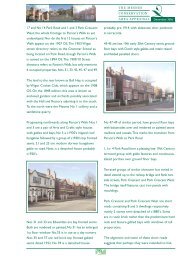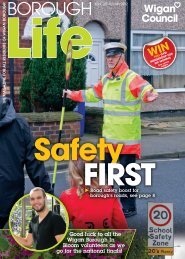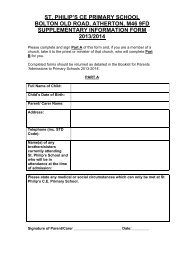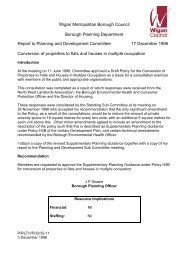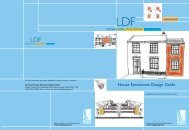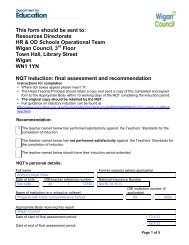Level 2 Strategic Flood Risk Assessment (.pdf ... - Wigan Council
Level 2 Strategic Flood Risk Assessment (.pdf ... - Wigan Council
Level 2 Strategic Flood Risk Assessment (.pdf ... - Wigan Council
Create successful ePaper yourself
Turn your PDF publications into a flip-book with our unique Google optimized e-Paper software.
For example, flooding may affect key infrastructure such as transport routes and bridges thatprovide emergency access during flooding events. Sewer networks may also be inundated,causing flooding in locations outside the expected extent of fluvial flooding and withinbasements.Hazard, velocity and depth mapping (<strong>Flood</strong> Zone 3 including climate change) have beenproduced as digital appendices to this report. Additional mapping developed for this SFRAare considered secondary sources of information that help to quantify the severity of floodingand risk. This addition mapping enhances the available EA data.In general, the SFRA modelled outlines are similar to the existing EA <strong>Flood</strong> Zones. Thisdemonstrates that fluvial flood risk is generally contained within clearly defined and low-lyingareas of <strong>Wigan</strong>. As with all SFRAs, the EA's <strong>Flood</strong> Zone Maps remain the primary source offlood mapping as they relate to UK planning policy. Please refer to the User Guide for moreinformation on how to use and prioritise the mapping data included in this SFRA.The hazard, velocity and depth mapping associated with the study have been developedusing an undefended JFLOW scenario using Environment Agency Digital Terrain Mappingand <strong>Flood</strong> Estimation Handbook catchment descriptors. This is considered a precautionaryapproach as the NFCDD defence database indicates that the majority of watercourses in theborough have defences maintained to a 2% to 2.5% AEP standard.Analysis of potential flood risk without defences for a 5% AEP event indicates that the extentof flooding will be confined to the river corridor. In order to take account of the limitedinformation on the integrity of defences, the undefended scenario represents a potential zoneof rapid inundation and higher risk.Modelling results used to define areas of high risk and rapid inundation were based on theavailable modelling data provided by the Environment Agency. This information has beensupplemented with additional strategic modelling and mapping techniques to provide anoverview of areas that are at significant flood hazard.2.11 <strong>Flood</strong> Hazard ZonesThe model outputs record the extent, depth and hazard associated with fluvial flooding. <strong>Flood</strong>Hazard describes the flood conditions that are likely to affect people. It is a combination offlood depth, velocity and includes consideration of debris and obstruction to flows within riverchannels. The variables used in the flood hazard rating are;Depth of flood water (metres)Velocity of flood water (metres /second)Debris factor (score)The <strong>Flood</strong> Hazard Rating is calculated using the following equation:HR = d x (v + 0.5) + DFWhere, HR = (flood) hazard rating; d = depth of flooding (metres); v = velocity of floodwaters(metres/sec); and DF = debris factor calculated using Table 2-4.Table 2-4: Debris Factors for <strong>Flood</strong> Depths, Velocities and Dominant Land UsesDepths (metres) Pasture/Arable Woodland Urban0 to 0.25 0 0 00.25 to 0.75 0 0.5 1d>0.75 and/or v>2 0.5 1 1For the <strong>Wigan</strong> SFRA, flood hazard has been presented on the following scale:2009s0578 Final SFRA with Environment Agency Comments - L2 Ver5 <strong>Wigan</strong>.doc 16








